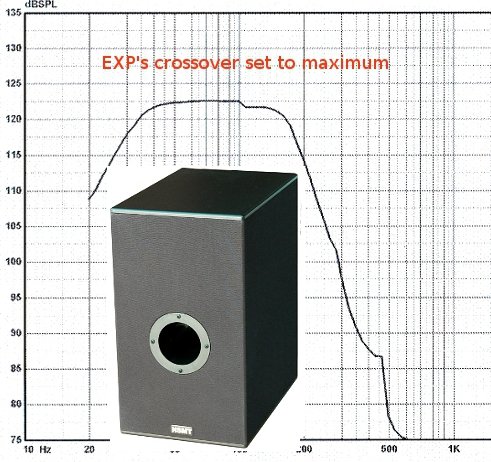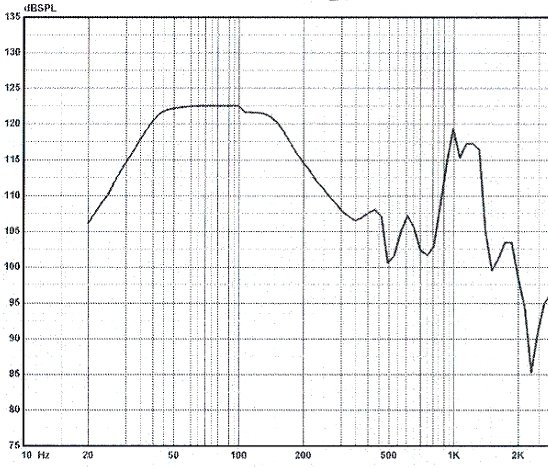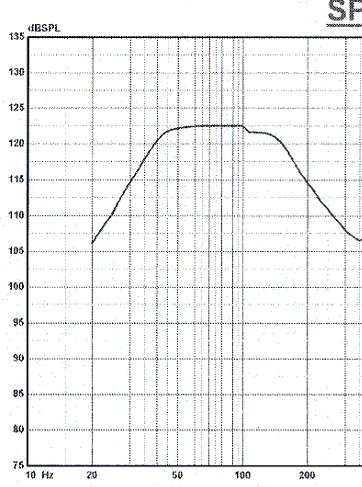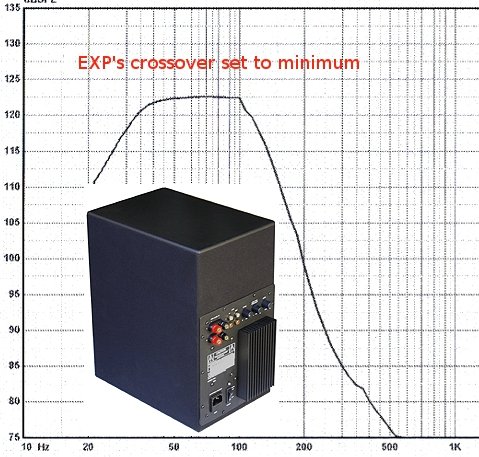B-STOCK SALE! |
EXP's Design
The EXP Active Bandpass Subwoofer
Anatomy of a subwoofer's response

OVERVIEW
The EXP is a potent self powered (active) mini subwoofer system that is designed for use in high-end stereo and home theater systems. It's frequency response is variable (by crossover setting) and extremely neutral: +/- 3.5 dB from 27 Hz to 195 Hz. It uses a custom long-throw 6.5 inch poly cone woofer in a bandpass cabinet design and a potent 100 watt full-featured amplifier to produce quick, accurate, powerful bass response. The back of the woofer is mounted in an acoustic suspension sub enclosure that produces quick, accurate, transient response. The front of the woofer fires into a vented sub-enclosure that shapes the woofer’s response, producing flat, extended, bass.
The hallmark of the EXP is its ability to integrate well with large and small speakers because of the flatness of its frequency response over a wide frequency range. This allows the EXP to integrate especially well with very small speakers. The EXP's unusual bandpass design produces flatter bass response over a wider frequency range and faster transient response than virtually all subwoofers.
While the frequency response of most active subwoofers is primarily dependent on elaborate artificial shaping of the response by electronic means, the EXP subwoofer achieves exemplary, linear frequency response primarily through the natural and harmonious mating of its high quality driver and its sophisticated bandpass cabinet design. As a result, bass produced by the EXP is natural sounding, musical, extremely neutral, highly articulate, and simply "right."
The EXP's amplifier includes both high and low level inputs, continuous phase adjustment, auto on/off switch (activated by input signal), adjustable volume level, and an electronic crossover that is continuously variable from 50 to 120 Hz. The amplifier sums the right and left stereo inputs to a mono output, so that one subwoofer may be used per system. The amplifier has thermal, overload and fuse protection for years of reliable use.
BASS REINFORCEMENT VS BASS REPLACEMENT
The EXP is designed for bass reinforcement as opposed to bass replacement. In the old days of passive subwoofers, integrating the responses of a subwoofer and satellites speakers had to be precise with little or no overlap in frequency response because passive subwoofers did not have active phase control to bring the frequency response of the subwoofer and satellites into phase alignment. With the advent of the active subwoofer it is best to think of a good subwoofer as providing bass reinforcement. The response of the subwoofer and satellites can overlap provided both responses are in phase and neither response is "peaky." Because the EXP has a very flat frequency response over an extended frequency range, you can set the crossover high and allow considerable overlap between the subwoofer and satellites speakers' outputs, by using the variable phase control to bring the EXP and satellite or theater speakers into phase alignment.

Figure 1: The EXP cabinet and woofer "natural" response (without amplifier or crossover) shows a remarkable neutral frequency response that is +/- 5 dB from 27 to 250 Hz, with a natural 12 dB roll-off pattern. This can be seen if we isolate the 20 Hz to 250 Hz part of the curve as shown in Figure 2 below. The 12 dB per octave crossover in the EXP's amplifier is needed to tame the break-up mode of the woofer that peaks at 1,000 Hz.
The EXP, bandpass cabinet (a combination of acoustic suspension or sealed box and vented box design), produces the excellent transient response characteristics of sealed box designs and the high bass efficiency of vented designs.
Figure 1, shows the frequency response of the EXP from 20 Hz to 250 Hz, without any crossover, active or passive, is "text book" neutral +/-5 dB from 27 Hz to 225 Hz and an even more impressive +/- 3.5 dB from 31 Hz to 195 Hz which meets the THX standard for subwoofers. Therefore, even when driven directly with any amplifier without a crossover the natural frequency response of the EXP would mate well with just about any loudspeaker because of its neutrality in the bass region and the natural roll-off pattern above 100 Hz produced by its bandpass design.
Above 500 cycles though, once can see, without attenuation, the break-up mode of the woofer centered around 1,000 cycles, could intrude into the performance of the system. The 12 dB role- off pattern of the amplifier's built-in crossover is used to attenuate this irregularity down to below 40 dBs below the subwoofer's useful response. This can be seen in figures 3 and 4 below.

Figure 2: The EXP cabinet and woofer "natural" response (without amplifier or crossover) from 20 to 250 Hz.
The active 100 watt amplifier provides convenience, flexibility, and an additional 12 dB attenuation to tame irregularities in the pass band of the frequency response of the EXP. As shown in Figure 3, below, with the crossover set to its minimum level, the frequency response of the EXP, driven by a 76.8 millivolt test signal into its 100 watt amplifier, shows a "text book" 24 dB per octave roll-off pattern from 100 Hz to 200 Hz. Notice that in all the graphs, the the low-end frequency roll-off pattern is always a less steep 12 dB which, with natural room reinforcement of bass frequencies, allows the EXP to deliver exceptional low bass performance.

Figure 3: EXP with 100 watt amplifier small signal frequency response with the crossover set to minimum level
CROSSOVER EFFECT
The setting of a subwoofer's crossover rarely has a direct 1 to 1 result on its frequency response and even less so in a bandpass subwoofer design. Setting the crossover to 100 cycles does not mean the subwoofer response stops at exactly 100 cycles, because the subwoofer's bass response is a combination of the responses of the subwoofer amplifier, the woofer, the volume of the input signal and the enclosure. Moreover, in a subwoofer like the EXP, where the shape of the subwoofer's frequency response is primarily determined by the bandpass cabinet design, the the effect of changing the crossover setting from minimum to maximum shown in Figures 3 and 4 mostly attenuates its frequency response and its slope above 100 Hz.

The crossover mostly attenuates the pass band of the EXP and combines with the natural roll of of the EXP to form a 24 dB roll off pattern. Because of this, the volume and phase can be equally critical as the crossover setting for integrating the EXP with speakers.
